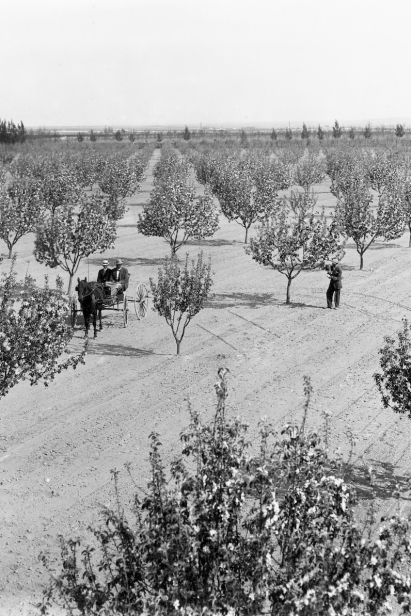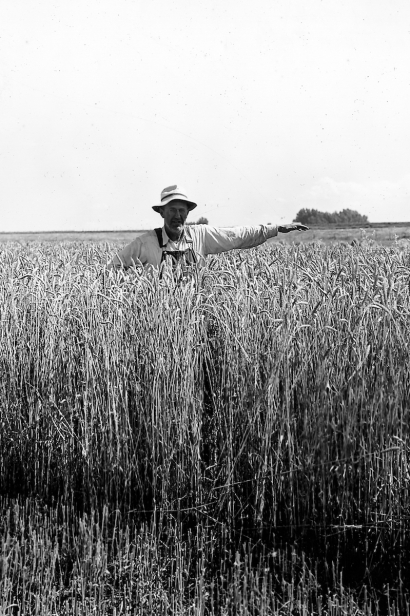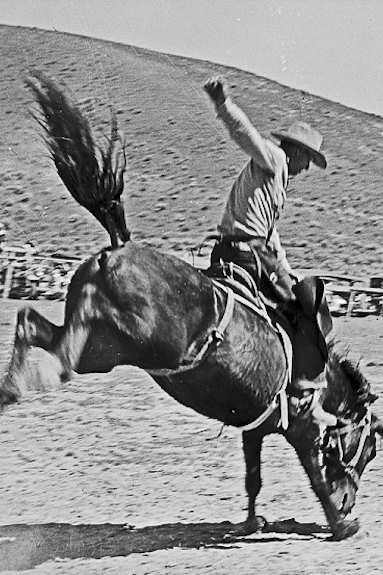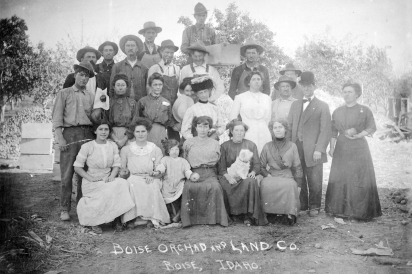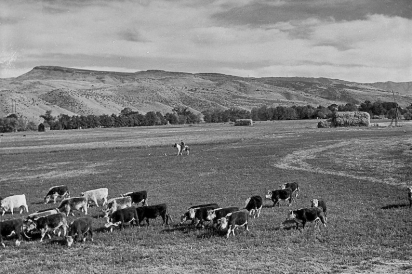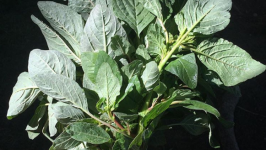Development Takes a Bite out of Farmland
When Phillip L. Schick followed a wandering ox into the Dry Creek Valley, he saw what many pioneers and homesteaders overlooked. While counterparts vied for mining claims in the Boise Basin, Schick knew he had stumbled onto another valuable resource 10 miles north of Boise: black gold lay just below the surface of the Dry Creek Valley and with the Boise Basin area exploding with miners, Schick figured their food had to come from somewhere. And the closer the better.
Dry Creek Valley fed Boise’s earliest settlers by producing a cornucopia of this and that in soil so rich that early growers yielded harvests using dry-farming methods, says Dry Creek Historical Society historian Jay Karamales.
“This was the bread basket for Boise, version 1.0,” Karamales says.
“It’s staggering the amount of food that came out of this valley.”
But as mining towns grew and shrank and Boise began to bustle, the Dry Creek Valley sank into obscurity and its prime farmland remained a bit of a secret. That changed with Boise’s population boom and the real estate potential developers saw in the land.
Lush green hills rise from the rich Dry Creek Valley springtime earth and postcard-perfect farmsteads dot the agrarian landscape crisscrossed by bubbling creeks, deer tracks and swatches of wildflowers. Except for the massive Hidden Springs residential development to the east, the Dry Creek Valley remains very much agrarian. For now.
“That will all change when we get a city dropped on us,” Karamales says of plans to erect a 1,400-acre development on what soil experts and open space conservationists call prime farmland.
“They don’t have to put it on top of this special ground,” Karamales says, pointing to the rural beauty, undisturbed open spaces and valuable agricultural resources that surround the old Schick farmstead.
“It’s heartbreaking.”
From Tractors to Tract Homes
Orchards once blanketed the Boise Bench, locals considered West Boise the countryside and cornfields stretched into the far west and south sides of Ada County where milkweed, plum trees and wild asparagus sprang from the ditches that transversed the farmland. Neighbors foraged asparagus and milkweed nurtured the farmlands’ pollinators. Press a Boise Valley local to find some of those asparagus stands now and they’ll likely come up dry. And the milkweed? It’s in short supply. In less than a generation, bulldozers gobbled up prime tracts of Idaho farmland and in the wake of the asparagus, plum orchards and milkweed stands, beige tract homes sprang from fields of asphalt and grass turf monocultures.
Idaho’s unprecedented growth birthed building booms that pushed the edges of development farther into the countryside, placing efforts to balance growth with sustainability at what “smart growth” advocates call a critical juncture in the state’s history. The onslaught of Idaho newcomers not only has emerging activist groups calling on local leaders and planners to rethink and harness the explosive growth in an effort to preserve Idaho’s enviable quality of life, but has growers and land use experts raising questions about how growth could impact our relationship with food as the farm moves farther and farther away from the table.
“People say, ‘How far has my food traveled?’ It’s going to be normal for it to come from 40, 50 miles away,” says Dry Creek area farmer Davis McDonald.
For locavores, distance matters and smart-growth advocates say more than miles could come between their table and the farm if growth continues unbridled and unchecked.
Complex economic, demographic and political forces along with a heavy dose of public relations, real estate advertisements, top 10 lists and social media bloggers and vloggers spilled the secret about Idaho’s quality of life and helped give rise to the state’s swelling population. YouTuber “Ivan the Intrepid” vlogs a now-typical social media swoon for the state’s capital city and casts a lure for out-of-staters to join the ballooning ranks of Gem State inhabitants. He touts Boise’s amicable locals, its unmatched outdoor scene and hip vibe with a glossy montage that makes even a cloudy afternoon in Boise look like a day in paradise. Come one, come all, his video says.
“Boise is a great place to live,” he entices viewers.
“I will be moving to Boise,” “I want to go to Idaho,” “My husband and I are moving to Boise…” “I LOVE Boise!” viewers chime back.
And move some did, joining an influx of newcomers that impregnate the edges of suburban sprawl and threaten a valuable resource locals are fighting to save: its farmland.
From 2016 to 2017, Idaho’s population swelled by 2.2%, adding 36,917 inhabitants to the state’s landscape, according to the U.S. Census Bureau. That influx equates to 101 newcomers per day, making Idaho the fastest-growing state in the nation. Much of that growth hit the Treasure Valley, where the capital city grew even faster in 2017, at a 3.8% rate, according to census reports. That boils down to roughly 48 newcomers arriving in Boise every day.
But missing from many of the sublime promo videos and blogs that attract transplants is a slice of Idaho’s rural landscape—the place where many newcomers plant roots with tract homes and asphalt.
The Crème de la Crème of Ag Land
Down the road from Fiddler’s Green Farms, in a swath of the Dry Creek Valley nestled between rolling foothills, small-scale farms and the occasional ranch house, lies the nearly 1,400 acres of prime farmland smart-growth activists hope to spare from the bulldozer.
Hunter Homes boasts plans to bring the farm to the table on the 1,400 rural acres that occupies wide-open space 11 miles north of Boise with a roughly 1,800-unit large lot development featuring equestrian trails, community garden space and “Idaho tradition.”
The farmland that’s increasingly swallowed by bulldozers leaves locals in a fight to preserve what’s left with petitions, attorneys and an appeal to common sense to protect not just a bucolic ethos and quality of life but the source of life: our food.
“We are at a critical juncture,” says Stephanie Rael, a farmer turned activist, who’s pushing efforts to halt the Hunter Homes development through the referendum process. “We need to place more value on food places.”
The population boom that began with the discovery of gold in the Boise Basin is nothing new to Idaho, but smart-growth advocates see Idaho’s recent growth as a kind of steroid-induced surge that’s leaving a scar across the state’s rural landscapes and wild places. And the scars leave more than a sore sight for sorry eyes, land use experts say, but directly impacts how locals and a nation eat and procure their food.
Idaho newcomers, transplants and returning natives need a place to call home and for developers, the flat, picturesque topography of farmland makes for a ready-to-develop landscape that’s just too irresistible to ignore. A Boise State study predicts Ada County could lose 240,000 acres of farmland by the year 2100 if growth continues unchecked at its current rate—a trend that concerns nearly 55% of residents, according to Boise State University’s 2017 Treasure Valley Survey.
That disappearing farmland should concern more than Idaho residents, says Julia Freegood, assistant vice president of programs with American Farmland Trust (AFT).
“Even though you’re known for your potatoes, that’s not really what’s grown around Boise,” Freegood says.
“You have a lot of production that’s not only important to Idaho but is important to the nation.”
Boise area farms produce a dizzying array of seeds that farmers across the nation sow, giving a considerable chunk of produce grown across the country Idaho roots.
But as important as local farmland is to a nation, Idahoans also need that local farmland.
Freegood says that most local communities are so dependent on outside food sources that should a catastrophic event block the transport of food from distant farms to local tables, large cities could see food supplies at local grocers dwindle within two weeks. Local food supplies and thus local farms bolster food security, she says.
Dwindling farmland resources could certainly imperil Idaho in many of the same ways nationwide losses affect other states and communities. But Freegood says there’s something special about Idaho farmland.
“Your state has some of the most productive land in the country,” she says.
A multi-year AFT soil mapping study recently uncovered what lies beneath the surface of Idaho’s farmland. Historic volcanic activity blanketed much of the state with nutrient-rich ash that could grow a lot more than potatoes.
“If you look around Boise there’s this circle of green where you have what we call MPVR—most productive, versatile and resistant land. You have some of the most valuable land in the country right in your state. And that is the land that is most under threat of development because it is right near Boise and Boise is growing really rapidly.”
That nutrient dense, high quality and uber resilient soil comprises less than 20% of farmland across the United States, making Idaho farmland not only incredibly valuable, but incredibly rare.
“This is the crème de la crème of agricultural land,” Freegood says. “You have a really precious, irreplaceable resource and we need to treat it with the respect it deserves."
You Can't Get It Back
In the fertile Dry Creek Valley north of Boise, Davis McDonald plants lettuce starts in the blackened soil at Fiddler’s Green Farm. Behind him, just to the south, looms a remnant of the area’s farming history and a slice of land slated for a Hunter Homes development.
“We needed to save it 10 years ago, but I was 10, 15 years old,” McDonald says.
“You can’t get it back,” chimes in Fiddler’s Green co-owner and farmer Justin Moore, lamenting the changes that could come with the controversial Dry Creek Ranch development.
“Why not go somewhere that’s not prime, beautiful farmland?” Moore asks.
For Moore and other Dry Creek farmers the stakes are high. Transforming the rural Dry Creek landscape into residential development could—among other environmental and infrastructure pressures— destabilize the local aquifer with unquenchable lawns and excessive domestic water use, forcing area growers to dig deeper and deeper into local wells.
“That’s a lot of homes and most people who live there will not be saving water,” Moore says.
And although Hunter Homes, which did not respond to a request for an interview, promises a “farm to table” theme in its new development, Fiddler’s Green co-owner Alex Bowman-Brown doubts many of the Dry Creek Ranch residents would do much farming after commuting home from work across two valleys. McDonald points to the community gardens at the nearby Hidden Springs development that stand neglected and weed ridden.
“There’s no farming there and none of the neighbors want to have anything to do with it,” Bowman-Brown says.
But McDonald and company want to farm. And if the farmers hadn’t found land to lease so close to Boise, they doubt they and other young growers could find a way to bring produce to the capital city’s locavores. Urban farm plots remain a rarity and most young people don’t want to relocate 40 or 50 miles from the city, they say.
“When you start to eat up your best land, you start to erode our ability as a nation to feed ourselves and a growing population over time,” Freegood says. “Our land is really ideal for food and crop production and as we take that away, what are the implications for our domestic food supply over time?”
Dry Creek Historical Society
Fiddler’s Green Farms | @fiddlersgreenfarms
Hunter Homes
American Farmland Trust | @americanfarmlandtrust
Dry Creek Ranch
Hidden Springs



